ignition MERCEDES-BENZ SLS AMG GT COUPE 2015 C197 Owner's Manual
[x] Cancel search | Manufacturer: MERCEDES-BENZ, Model Year: 2015, Model line: SLS AMG GT COUPE, Model: MERCEDES-BENZ SLS AMG GT COUPE 2015 C197Pages: 290, PDF Size: 6.24 MB
Page 15 of 290
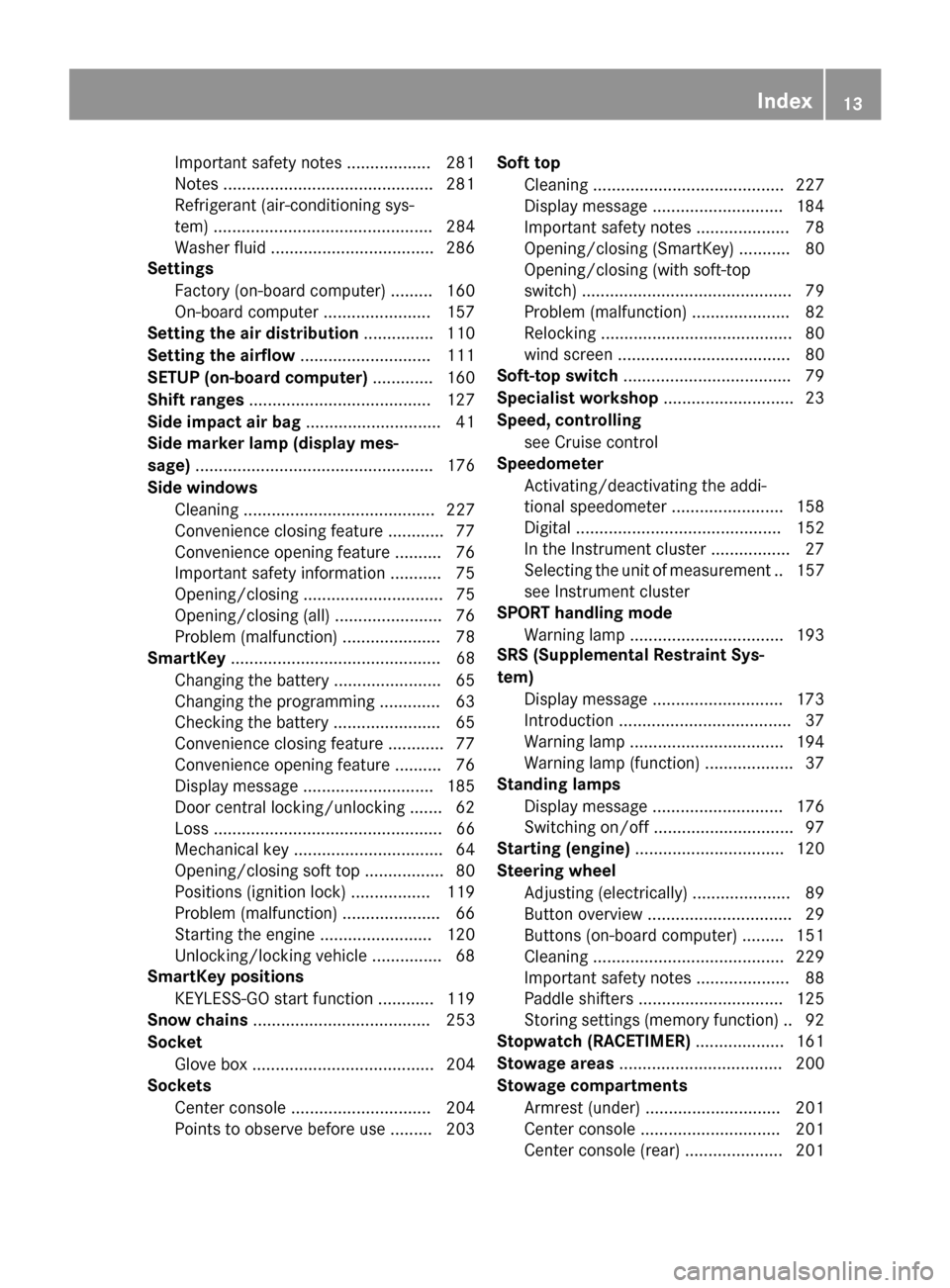
Important safety notes .................. 281
Notes .............................................2
81
Refrigerant (air-conditioning sys-
tem) ............................................... 284
Washer fluid ................................... 286
Settings
Factory (on-board computer) ......... 160
On-board computer ....................... 157
Settin gthe air distribution ...............110
Settin gthe airflow ............................ 111
SETUP (on-board computer) ............. 160
Shift ranges ....................................... 127
Side impact air bag .............................41
Side marker lamp (display mes-
sage) ................................................... 176
Side windows Cleaning ......................................... 227
Convenienc eclosing feature ............ 77
Convenienc eopening feature ..........76
Important safety information ........... 75
Opening/closing .............................. 75
Opening/closing (all) ....................... 76
Proble m(malfunction) .....................78
SmartKey ............................................. 68
Changing the battery ....................... 65
Changing the programming .............63
Checkin gthe battery ...................... .65
Convenience closin gfeature ............ 77
Convenience opening feature .......... 76
Display message ............................ 185
Door central locking/unlocking ...... .62
Loss .................................................66
Mechanical key ................................ 64
Opening/closing soft top ................. 80
Positions (ignition lock) ................. 119
Problem (malfunction) ..................... 66
Starting the engine ........................ 120
Unlocking/locking vehicle ............... 68
SmartKey positions
KEYLESS-GO start function ............ 119
Snow chains ...................................... 253
Socket Glove box ....................................... 204
Sockets
Center console .............................. 204
Points to observe before use ......... 203 Soft top
Cleaning ......................................... 227
Display message ............................1 84
Important safety notes .................... 78
Opening/closing (SmartKey) ........... 80
Opening/closing (with soft-top
switch) ............................................. 79
Problem (malfunction) ..................... 82
Relocking ......................................... 80
wind screen ..................................... 80
Soft-top switch ................................... .79
Specialist workshop ............................23
Speed, controlling see Cruise control
Speedometer
Activating/deactivating the addi-
tional speedometer ........................ 158
Digital ............................................ 152
In the Instrument cluster ................. 27
Selectingt he unit of measurement .. 157
see Instrument cluster
SPORT handling mode
Warning lamp ................................. 193
SRS (Supplementa lRestraint Sys-
tem) Display message ............................1 73
Introduction ..................................... 37
Warning lamp ................................. 194
Warning lamp (function) ................... 37
Standin glamps
Display message ............................ 176
Switching on/off .............................. 97
Starting (engine) ................................ 120
Steering wheel Adjusting (electrically). .................... 89
Button overview ............................... 29
Buttons (on-board computer) ......... 151
Cleaning ......................................... 229
Important safety notes .................... 88
Paddle shifters ............................... 125
Storing settings (memory function) .. 92
Stopwatch (RACETIMER) ................... 161
Stowage areas ................................... 200
Stowage compartments Armrest (under) ............................ .201
Center console .............................. 201
Center console (rear) ..................... 201 Index
13
Page 23 of 290
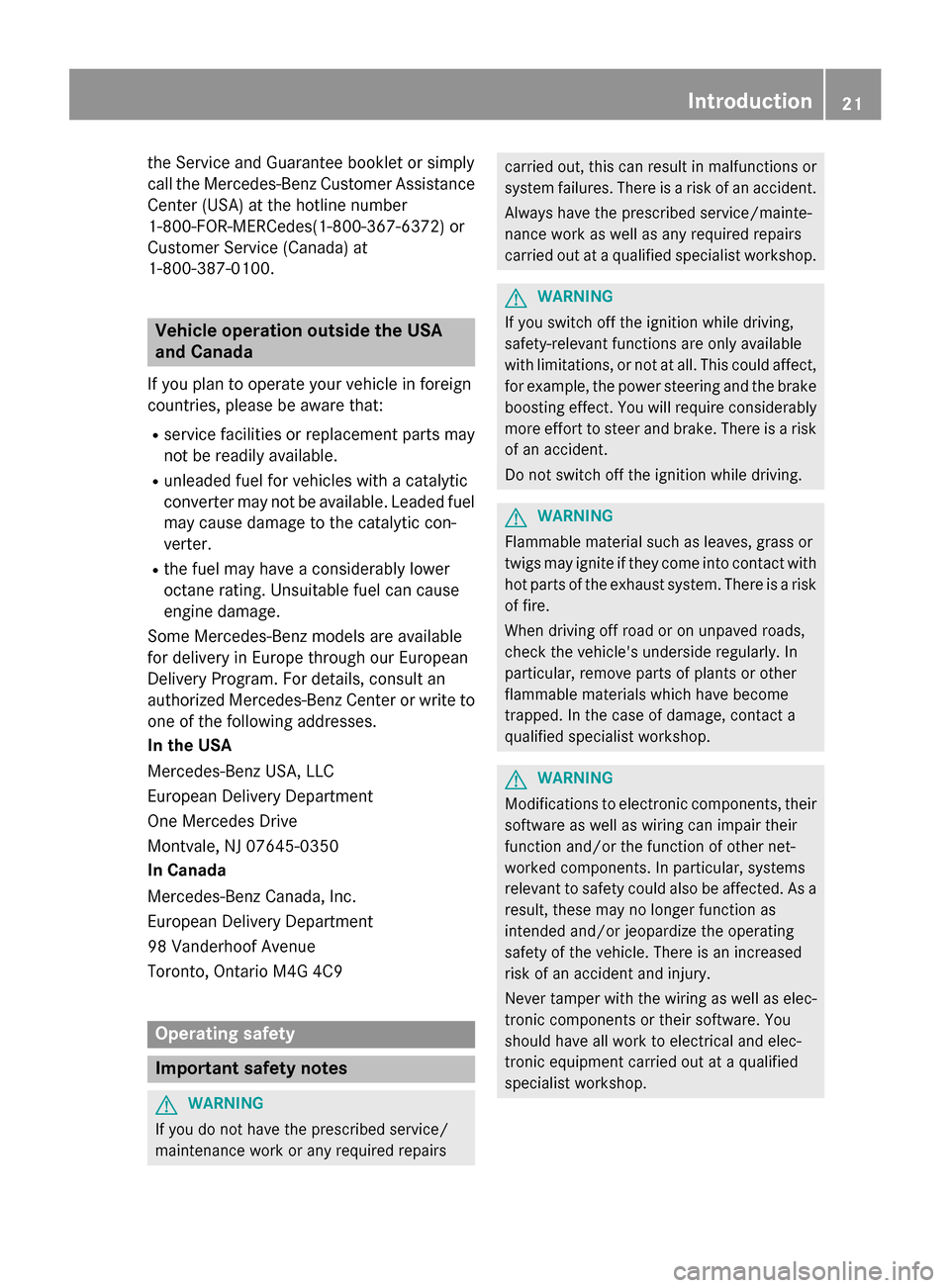
the Service and Guarante
ebooklet or simply
cal lthe Mercedes-Benz Customer Assistance
Center (USA) at the hotline number
1-800-FOR-MERCede s(1-800-367-6372 )or
Customer Servic e(Canada) at
1-800-387-0100. Vehicle operation outside the USA
and Canada
If you plan to operate your vehicle in foreign
countries, please be aware that: R service facilities or replacement parts may
not be readily available.
R unleaded fuel for vehicles with acatalytic
converter may not be available. Leaded fuel may cause damage to the catalytic con-
verter.
R the fuel may have aconsiderably lower
octaner ating. Unsuitable fuel can cause
engine damage.
Some Mercedes-Benz models are available
for delivery in Europe through our European
Delivery Program. For details, consult an
authorized Mercedes-Benz Center or write to
one of the following addresses.
In the USA
Mercedes-Benz USA,L LC
European Delivery Department
One Mercedes Drive
Montvale, NJ 07645-0350
In Canada
Mercedes-Benz Canada, Inc.
European Delivery Department
98 Vanderhoof Avenue
Toronto, Ontario M4G 4C9 Operating safety
Important safety notes
G
WARNING
If you do not have the prescribed service/
maintenance work or any required repairs carried out, this can result in malfunctions or
system failures. There is arisk of an accident.
Always have the prescribed service/mainte-
nancew ork as well as any required repairs
carried out at aqualified specialist workshop. G
WARNING
If you switch off the ignition while driving,
safety-relevant functions are only available
with limitations, or not at all. This could affect, for example, the power steering and the brake
boosting effect .You will require considerably
more effort to steer and brake. There is arisk
of an accident.
Do not switch off the ignition while driving. G
WARNING
Flammable material such as leaves, grass or
twigs may ignite if they come into contact with hot parts of the exhaust system. There is arisk
of fire.
When driving off road or on unpaved roads,
check the vehicle's underside regularly. In
particular, remove parts of plants or other
flammable materials which have become
trapped. In the case of damage, contact a
qualified specialist workshop. G
WARNING
Modifications to electronic components, their software as well as wiring can impair their
function and/or the function of other net-
worked components. In particular, systems
relevant to safety could also be affected. As a
result, these may no longer function as
intended and/or jeopardize the operating
safety of the vehicle. There is an increased
risk of an accident and injury.
Never tamper with the wiring as well as elec-
tronic components or their software. You
should have all work to electrical and elec-
tronic equipment carried out at aqualified
specialist workshop. Introduction
21 Z
Page 38 of 290
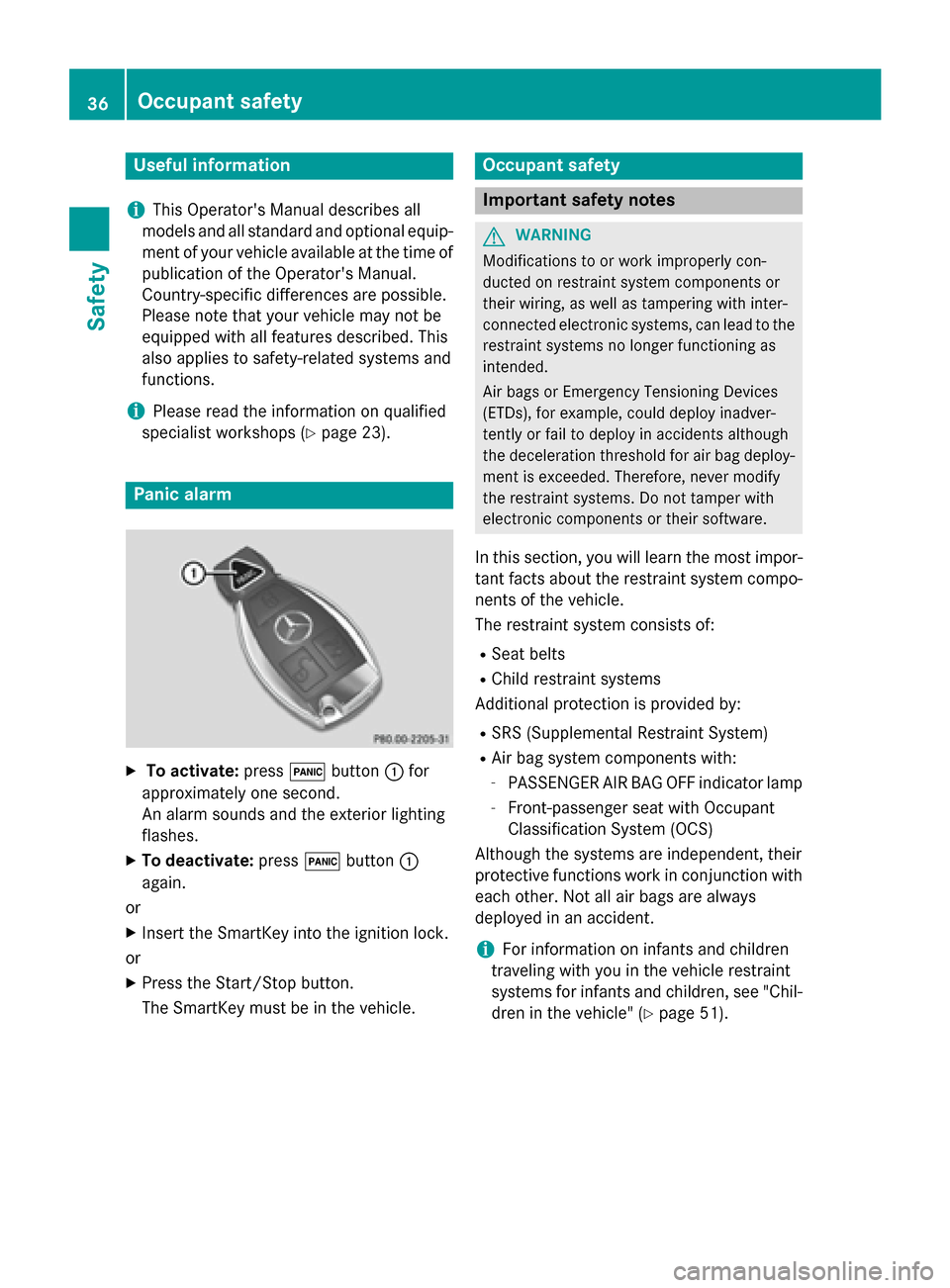
Useful information
i This Operator's Manual describes all
models and all standard and optional equip- ment of your vehicle available at the time of
publication of the Operator's Manual.
Country-specific differences are possible.
Please not ethat your vehicle may not be
equipped with all feature sdescribed. This
also applies to safety-related system sand
functions.
i Please read the information on qualified
specialist workshops (Y page 23).Panic alarm
X
To activate: press0033button 0043for
approximately one second.
An alarm sounds and the exterior lighting
flashes.
X To deactivate: press0033button 0043
again.
or
X Insert the SmartKey int othe ignition lock.
or X Press the Start/Stop button.
The SmartKey must be in the vehicle. Occupant safety
Important safet
ynotes G
WARNING
Modifications to or work improperly con-
ducted on restraint system components or
their wiring, as well as tampering with inter-
connected electronic systems, can lead to the restraint system snolonger functioning as
intended.
Air bags or Emergenc yTensioning Devices
(ETDs), for example, could deploy inadver-
tently or fail to deploy in accidents although
the deceleration threshold for air bag deploy- ment is exceeded. Therefore, neve rmodify
the restraint systems. Do not tamper with
electronic components or their software.
In this section, you will learn the most impor-
tan tfact sabout the restraint system compo-
nents of the vehicle.
The restraint system consists of:
R Seat belts
R Child restraint systems
Additional protection is provided by:
R SRS (Supplemental Restrain tSystem)
R Air bag system components with:
- PASSENGER AIR BAGO FF indicator lamp
- Front-passenger seat with Occupant
Classification System (OCS)
Although the system sare independent ,their
protective function swork in conjunction with
each other .Not all air bags are always
deployed in an accident.
i For information on infants and children
traveling with you in the vehicle restraint
system sfor infants and children ,see "Chil-
dren in the vehicle" (Y page 51).36
Occupant safetySafety
Page 39 of 290
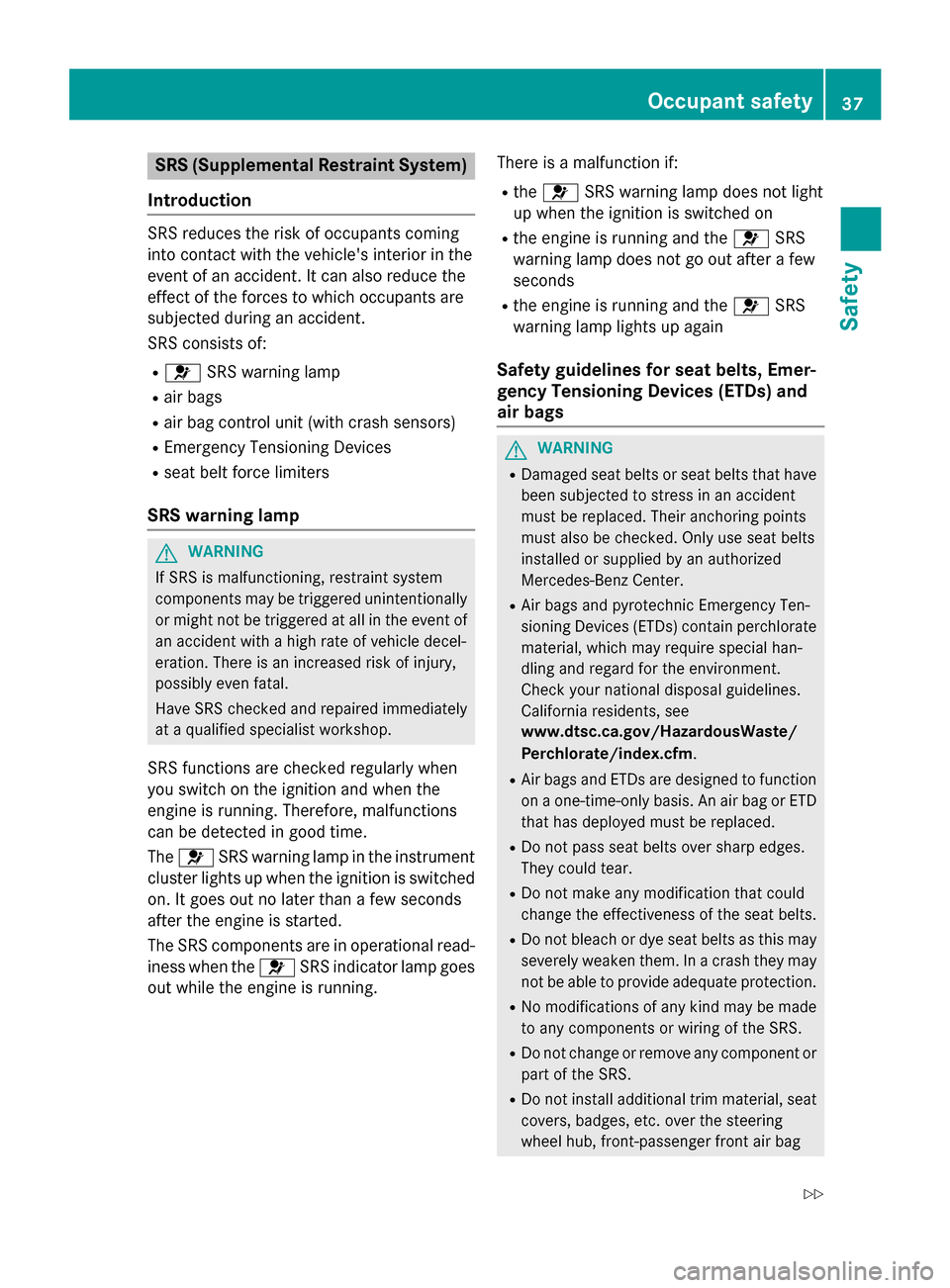
SRS (Supplementa
lRestraint System)
Introduction SRS reduces the risk of occupants coming
into contact with the vehicle's interior in the
event of an accident. It can also reduce the
effect of the forces to which occupants are
subjected during an accident.
SRS consistso f:
R 0075 SRS warning lamp
R air bags
R air bag control unit (with crash sensors)
R Emergency Tensioning Devices
R seat belt force limiters
SRS warning lamp G
WARNING
If SRS is malfunctioning, restraint system
components may be triggered unintentionally
or might not be triggered at all in the event of
an accident with ahigh rate of vehicle decel-
eration. There is an increased risk of injury,
possibly even fatal.
Have SRS checked and repaired immediately
at aq ualified specialist workshop.
SRS functions are checked regularly when
you switch on the ignition and when the
engine is running. Therefore, malfunctions
can be detected in good time.
The 0075 SRS warning lamp in the instrument
cluster lights up when the ignition is switched on. It goes out no later than afew seconds
after the engine is started.
The SRS components are in operational read-
iness when the 0075SRS indicator lamp goes
out while the engine is running. There is
amalfunction if:
R the 0075 SRS warning lamp does not light
up when the ignition is switched on
R the engine is running and the 0075SRS
warning lamp does not go out after afew
seconds
R the engine is running and the 0075SRS
warning lamp lights up again
Safety guidelines for seat belts, Emer-
gency Tensioning Devices (ETDs) and
air bags G
WARNING
R Damaged seat belts or seat belts that have
been subjected to stress in an accident
must be replaced. Their anchoring points
must also be checked. Only use seat belts
installed or suppliedbyana uthorized
Mercedes-Benz Center.
R Air bags and pyrotechnic Emergency Ten-
sioning Devices (ETDs) contain perchlorate
material, which may require special han-
dling and regard for the environment.
Check your national disposal guidelines.
California residents, see
www.dtsc.ca.gov/HazardousWaste/
Perchlorate/index.cfm .
R Air bags and ETDs are designed to function
on aone-time-only basis. An air bag or ETD
that has deployedm ust be replaced.
R Do not pass seat belts over sharp edges.
They could tear.
R Do not make any modification that could
change the effectiveness of the seat belts.
R Do not bleach or dye seat belts as this may
severely weaken them. In acrash they may
not be able to provide adequate protection.
R No modifications of any kind may be made
to any components or wiring of the SRS.
R Do not change or remove any componen tor
part of the SRS.
R Do not install additional trim material, seat
covers, badges, etc. over the steering
wheel hub, front-passenger front air bag Occupant safety
37Safety
Z
Page 47 of 290
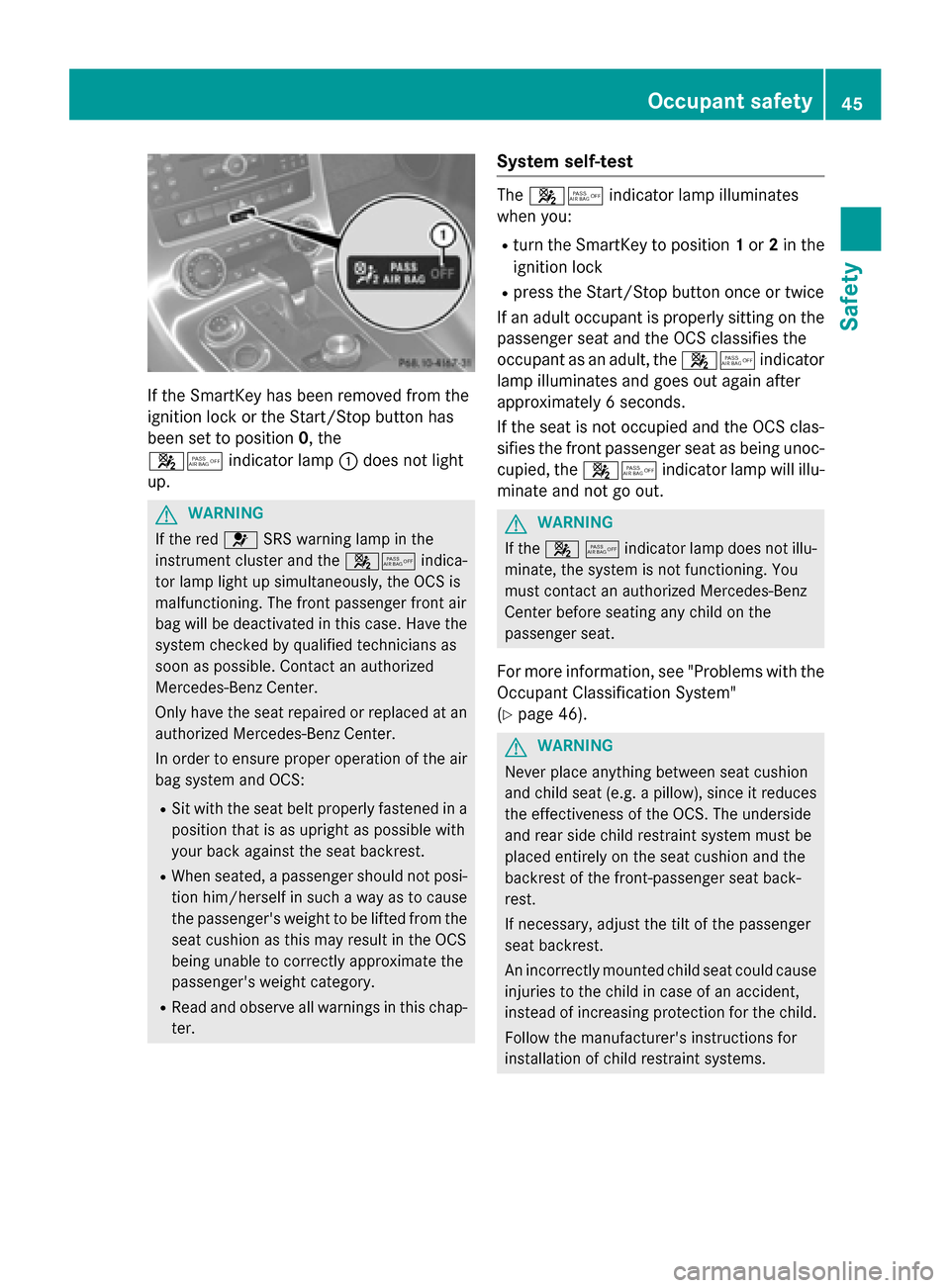
If the SmartKey has been removed from the
ignition lock or the Start/Stop button has
been set to position 0,the
00730074 indicator lamp 0043does not light
up. G
WARNING
If the red 0075SRS warning lamp in the
instrument cluster and the 00730074indica-
tor lamp lightu psimultaneously, the OCS is
malfunctioning. The front passenger front air
bag willbed eactivated in this case. Have the
system checked by qualifiedt echnicians as
soon as possible. Contact an authorized
Mercedes-Benz Center.
Only have the seat repaired or replaced at an
authorized Mercedes-Benz Center.
In order to ensure proper operation of the air
bag system and OCS:
R Sit with the seat belt properl yfastened in a
positio nthat is as upright as possible with
yourb ack against the seat backrest.
R When seated, apassenger shouldn ot posi-
tion him/hersel finsuchaway as to cause
the passenger's weight to be lifted from the seat cushio nasthis may resultint he OCS
being unabletoc orrectly approximate the
passenger's weight category.
R Reada nd observe all warnings in this chap-
ter. System self-test The
00730074 indicator lamp illuminates
when you:
R turn the SmartKey to position 1or 2in the
ignition lock
R press the Start/Stop button once or twice
If an adult occupant is properl ysitting on the
passenger seat and the OCS classifies the
occupant as an adult, the 00730074indicator
lamp illuminates and goes out again after
approximately 6seconds.
If the seat is not occupie dand the OCS clas-
sifies the front passenger seat as being unoc-
cupied, the 00730074indicator lamp willi llu-
minate and not go out. G
WARNING
If the 00730074indicator lamp does not illu-
minate, the system is not functioning. You
must contac tanauthorized Mercedes-Benz
Center befor eseatin gany child on the
passenger seat.
For more information, see "Problem swith the
Occupant Classification System"
(Y page 46). G
WARNING
Never place anything betwee nseat cushion
and child seat (e.g. apillow), sinc eitreduces
the effectiveness of the OCS. The underside
and rear side child restraint system must be
placed entirely on the seat cushio nand the
backrest of the front-passenge rseat back-
rest.
If necessary, adjust the tilt of the passenger
seat backrest.
An incorrectly mounted child seat could cause
injuries to the child in case of an accident,
instead of increasin gprotection for the child.
Follow the manufacturer' sinstructions for
installation of child restraint systems. Occupant safety
45Safety Z
Page 52 of 290
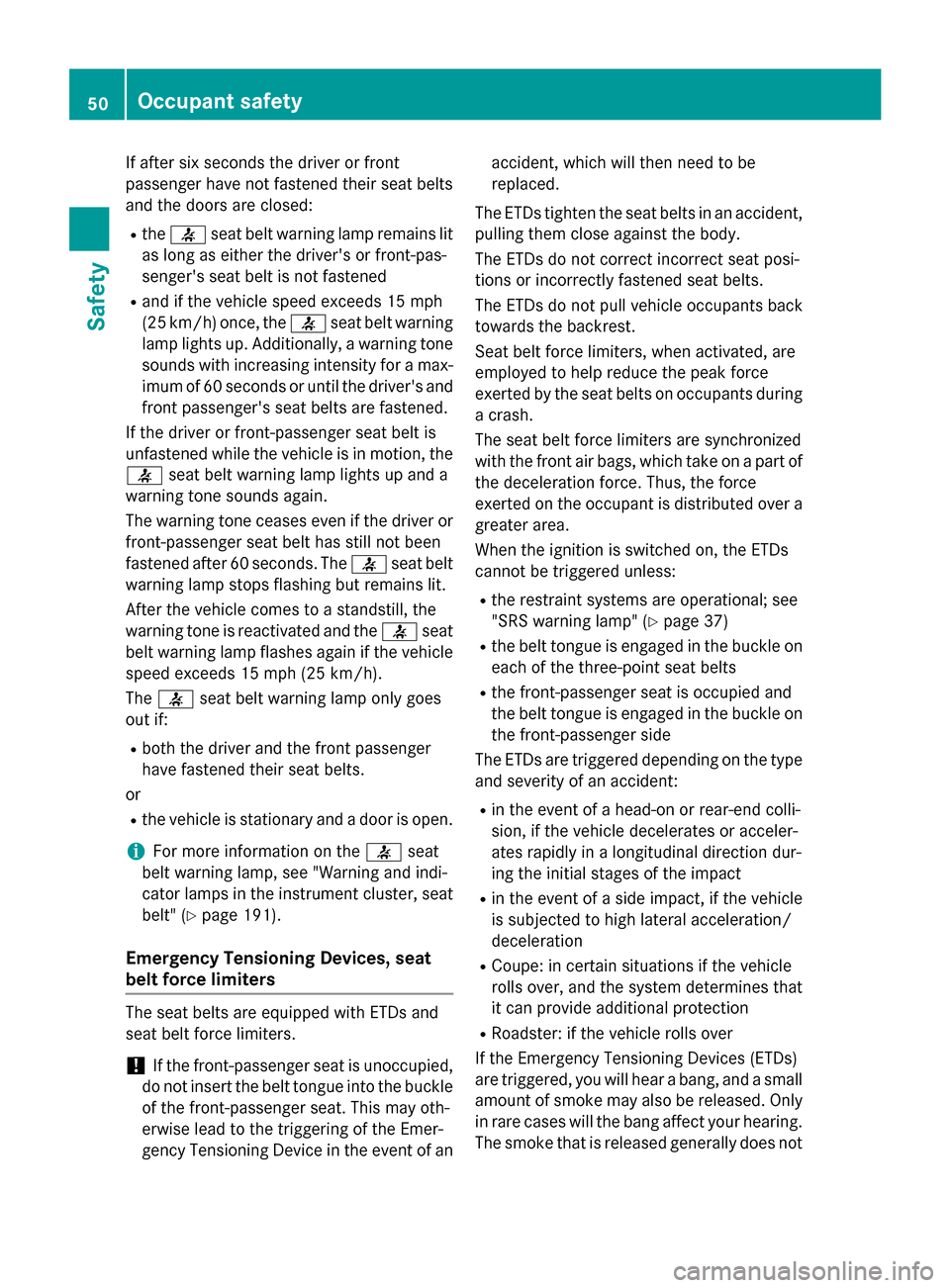
If after six seconds the driver or front
passenger have not fastened their seat belts
and the doors are closed:
R the 0076 seat belt warning lamp remains lit
as long as either the driver's or front-pas-
senger's seat belt is not fastened
R and if the vehicle speed exceeds 15 mph
(25 km/h )once, the 0076seat belt warning
lamp lights up. Additionally, awarning tone
sounds with increasing intensity for amax-
imum of 60 seconds or until the driver's and
front passenger's seat belts are fastened.
If the driver or front-passenger seat belt is
unfastened whilet he vehicle is in motion, the
0076 seat belt warning lamp lights up and a
warning tone sounds again.
The warning tone ceases even if the driver or
front-passenger seat belt has still not been
fastened after 60 seconds. The 0076seat belt
warning lamp stops flashing but remains lit.
After the vehicle comes to astandstill ,the
warning tone is reactivated and the 0076seat
belt warning lamp flashes again if the vehicle
speed exceeds 15 mph (25 km/h).
The 0076 seat belt warning lamp only goes
out if:
R both the driver and the front passenger
have fastened their seat belts.
or
R the vehicle is stationary and adoor is open.
i For more information on the
0076seat
belt warning lamp,s ee "Warning and indi-
cator lampsint he instrument cluster, seat
belt" (Y page 191).
Emergency Tensioning Devices, seat
beltf orce limiters The seat belts are equippedw
ith ETDs and
seat belt force limiters.
! If the front-passenger seat is unoccupied,
do not insert the belt tongue into the buckle of the front-passenger seat. This may oth-
erwisel eadtot he triggering of the Emer-
gency Tensioning Device in the event of an accident, which willt
hen need to be
replaced.
The ETDs tighten the seat belts in an accident,
pulling them close against the body.
The ETDs do not correct incorrect seat posi-
tions or incorrectly fastened seat belts.
The ETDs do not pullv ehicle occupants back
towards the backrest.
Seat belt force limiters, when activated, are
employed to help reduce the peak force
exerted by the seat belts on occupants during ac rash.
The seat belt force limiters are synchronized
with the front air bags,w hich take onapart of
the deceleration force. Thus, the force
exerted on the occupant is distributed over a
greater area.
When the ignition is switched on, the ETDs
cannot be triggered unless:
R the restraint systems are operational; see
"SRS warning lamp"( Ypage 37)
R the belt tongue is engage dinthe buckle on
each of the three-point seat belts
R the front-passenger seat is occupie dand
the belt tongue is engage dinthe buckle on
the front-passenger side
The ETDs are triggered depending on the type
and severity of an accident:
R in the event of ahead-on or rear-end colli-
sion, if the vehicle decelerates or acceler-
ates rapidly in alongitudinal direction dur-
ing the initial stages of the impact
R in the event of aside impact, if the vehicle
is subjected to high latera lacceleration/
deceleration
R Coupe: in certain situations if the vehicle
rolls over, and the system determines that
it can provide additional protection
R Roadster: if the vehicle rolls over
If the Emergency Tensioning Devices (ETDs)
are triggered, you willh earabang, and asmall
amount of smoke may also be released. Only
in rare cases willt he bang affect yourh earing.
The smoke that is released generally does not 50
Occupant safetySafety
Page 54 of 290
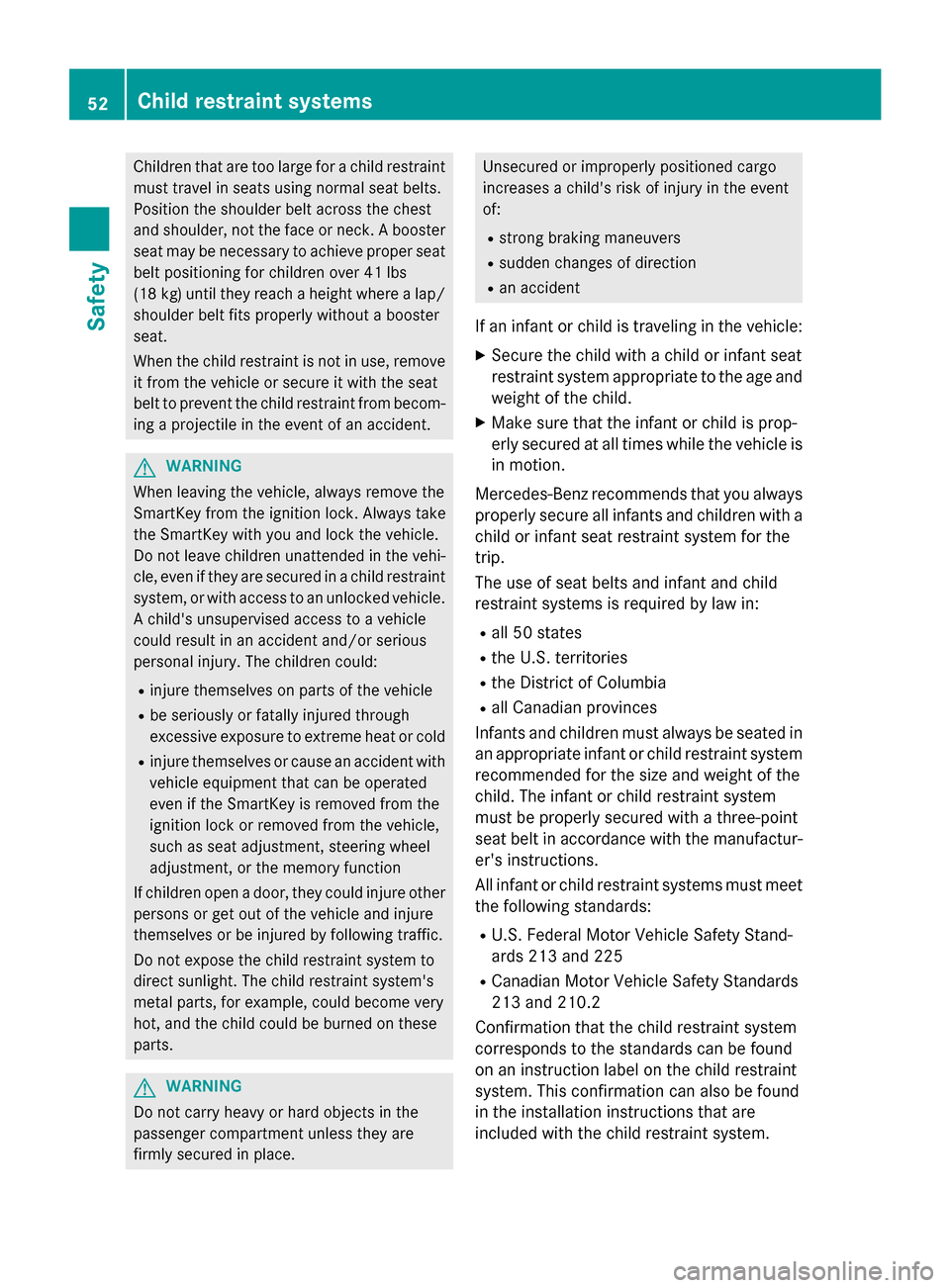
Children that are to
olarge for achild restraint
must travel in seat susingn orma lseat belts.
Positio nthe shoulder belt across th echest
and shoulder ,not thef aceorn eck.Abooster
seat may be necessary to achieve proper seat
belt positionin gfor children ove r41lbs
(18 kg )until they reac haheight wher ealap/
shoulder belt fit sproperly without abooster
seat.
When th echild restraint is no tinuse, remove
it from th evehicle or secure it wit hthe seat
belt to preven tthe child restraint from becom-
ing aprojectile in th eevent of an accident. G
WARNING
When leaving th evehicle ,always remove the
SmartKey from th eignition lock. Always take
th eS martKey wit hyou and loc kthe vehicle.
Do no tleave children unattende dinthevehi-
cle ,eve nift heya re secured in achild restraint
system, or wit haccess to an unlocked vehicle.
Ac hild's unsupervised access to avehicle
could result in an acciden tand/or serious
personal injury. The children could:
R injure themselve sonpartsoft hevehicle
R be seriously or fatally injured through
excessiv eexposur etoe xtrem eheat or cold
R injure themselve sorcauseana cciden twith
vehicle equipmen ttha tc an be operated
eve nift heSmartKey is remove dfromt he
ignition loc korremove dfromt hevehicle,
suc hass eat adjustment, steering wheel
adjustment, or th ememory function
If children open adoor ,the yc ould injure other
person sorget out of th evehicle and injure
themselve sorbeinjured by followin gtraffic.
Do no texpose th echild restraint system to
direct sunlight .The child restraint system's
metal parts, for example ,cou ld become very
hot ,and th echild could be burned on these
parts. G
WARNING
Do no tcarry heav yorhard object sinthe
passenger compartmen tunless they are
firmly secured in place. Unsecured or improperly positione
dcargo
increases achild's ris kofinjury in th eevent
of:
R stron gbraking maneuvers
R sudde nchanges of direction
R an accident
If an infant or child is traveling in th evehicle:
X Secure th echild wit hachild or infant seat
restraint system appropriat etotheage and
weigh tofthechild.
X Mak esure that th einfant or child is prop-
erly secured at all times while th evehicle is
in motion.
Mercedes-Ben zrecommends that you always
properl ysecure all infant sand childre nwitha
child or infant seat restraint system for the
trip.
The use of seat belt sand infant and child
restraint systems is required by law in:
R all 50 states
R theU .S.t erri tories
R theD istrict of Columbia
R all Canadian provinces
Infants and childre nmust always be seated in
an appropriat einfant or child restraint system
recommended for th esizea nd weigh tofthe
child. The infant or child restraint system
must be properl ysecured wit hathree-point
seat belt in accordanc ewitht he manufactur-
er' sinstructions.
All infant or child restraint systems must meet
th ef ollowin gstandards:
R U.S. Federal Motor Vehicle Safet yStand-
ards 21 3and 225
R Canadian Motor Vehicle Safet yStandards
21 3a nd 210.2
Confirmation that th echild restraint system
correspond stothestandards can be found
on an instruction label on th echild restraint
system. This confirmatio ncan also be found
in th einstallatio ninstruction sthata re
included wit hthe child restraint system. 52
Child restraint systemsSafety
Page 56 of 290
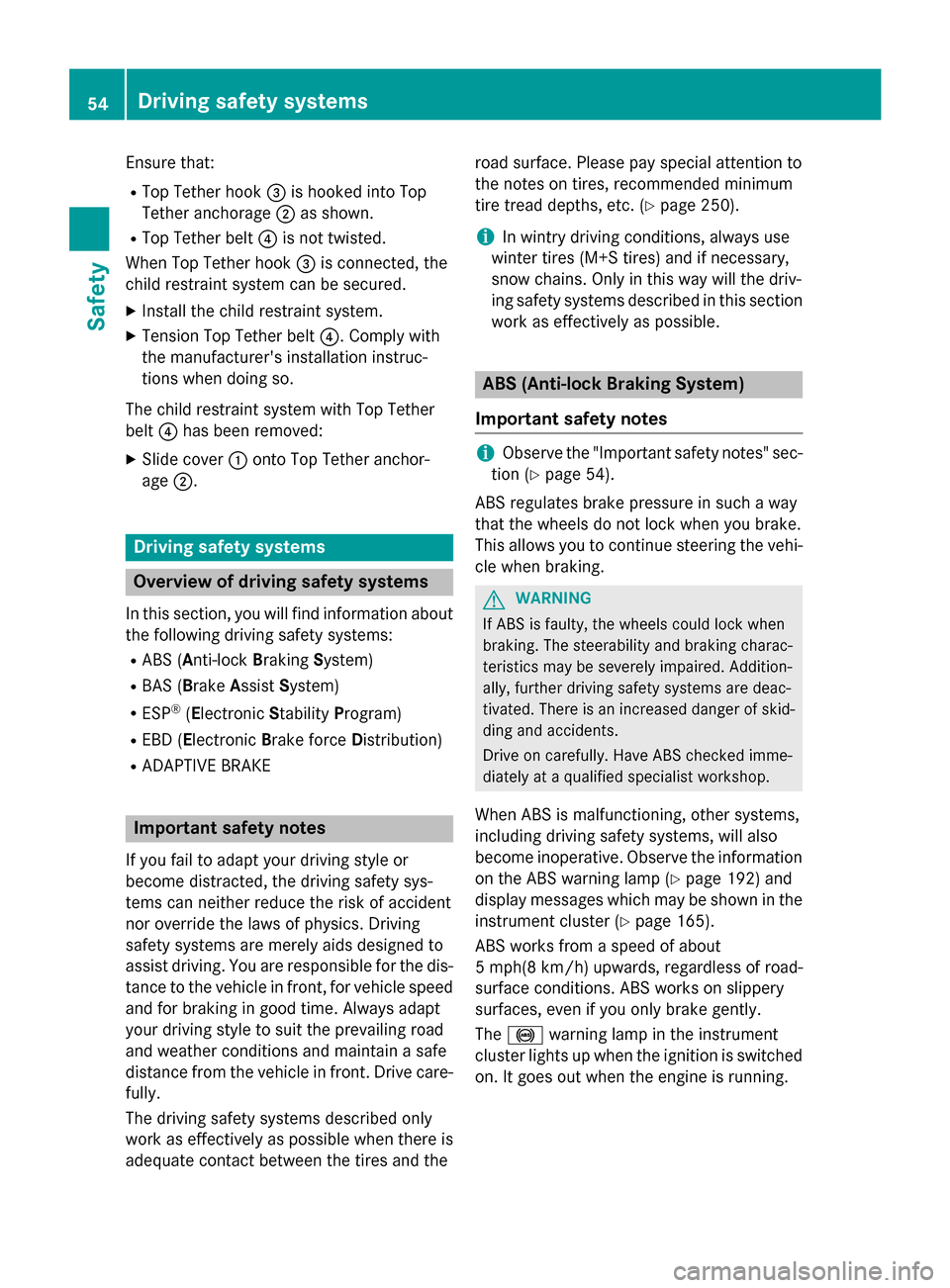
Ensure that:
R To pT ethe rh ook 0087is hooke dinto Top
Tethe ranchorage 0044as shown.
R To pT ethe rb elt 0085 is not twisted.
When To pTethe rh ook 0087is connected ,the
child restraint syste mcan be secured.
X Install the child restraint system.
X Tension To pTethe rb elt 0085.C om plyw ith
the manufacturer's installatio ninstruc-
tions when doing so.
Th ec hild restraint syste mwithT op Tether
belt 0085hasb eenr emoved:
X Slide cover 0043onto To pTethe ra nchor-
age 0044. Driving safety systems
Overvie
wofdrivingsafety systems
In thi ssection, yo uwillf in di nformation about
the following driving safety systems:
R ABS ( Anti-lock Braking System)
R BAS ( Brake Assist Sys tem)
R ESP ®
(Ele ctronic Stability Program)
R EBD ( Electronic Brake force Distribution)
R ADAPTIVE BRAKE Important safety notes
If yo ufailtoa dapt your driving style or
become distracted ,the driving safety sys-
tems can neithe rreduce the risk of accident
nor override the laws of physics .Driving
safety systems ar emerel yaidsd esig nedto
assist driving. Yo uareresponsibl efor the dis-
tance to the vehicl einfront, for vehicl espeed
and for braking in good time. Alway sadapt
your driving style to suit the prevailing road
and weather conditions and maintain asafe
distance fro mthe vehicl einfront. Drive care-
fully.
Th ed riving safety systems describe donly
work as effectivel yaspossibl ew hent here is
adequate contact between the tires and the roa
dsurface. Please pa yspecial attentio nto
the note sontires,recommended minimum
tir et rea ddepths, etc. (Y page 250).
i In wintry driving conditions
,alway suse
winter tires (M+S tires )and if necessary,
sno wchains .Onlyint hisw aywill the driv-
ing safety systems describe dinthiss ection
work as effectivel yaspossible. ABS (Anti-lock Braking System)
Important safety notes i
Observe the "Important safety notes" sec-
tio n(Ypage 54).
ABS regulate sbrake pressure in such away
tha tthe wheels do not lock when yo ubrake.
This allows yo utocontinue steering the vehi-
cle when braking. G
WARNING
If ABS is faulty, the wheels could lock when
braking .The steerability and braking charac-
teristics ma ybeseverel yimpaired. Addition-
ally ,fur the rdriving safety systems ar edeac-
tivated. There is an increase ddangerofs kid-
ding and accidents.
Drive on carefully. Have ABS checked imme-
diately at aquali fied specialis tworkshop.
When ABS is malfunctioning ,other systems,
including driving safety systems, will also
become inoperative. Observe the information on the ABS warning lamp (Y page 192)and
displa ymessage swhich ma ybeshown in the
instrument cluste r(Ypage 165).
ABS works fro maspeed of about
5m ph(8 km/h) upwards ,regardles sofroad-
surface conditions .ABS works on slippery
surfaces ,evenify ouonlybrake gently.
The 0025 warning lamp in the instrument
cluste rlight supw hent he ignition is switched
on. It goes ou twhent he engine is running. 54
Driving safet
ysystemsSafety
Page 57 of 290
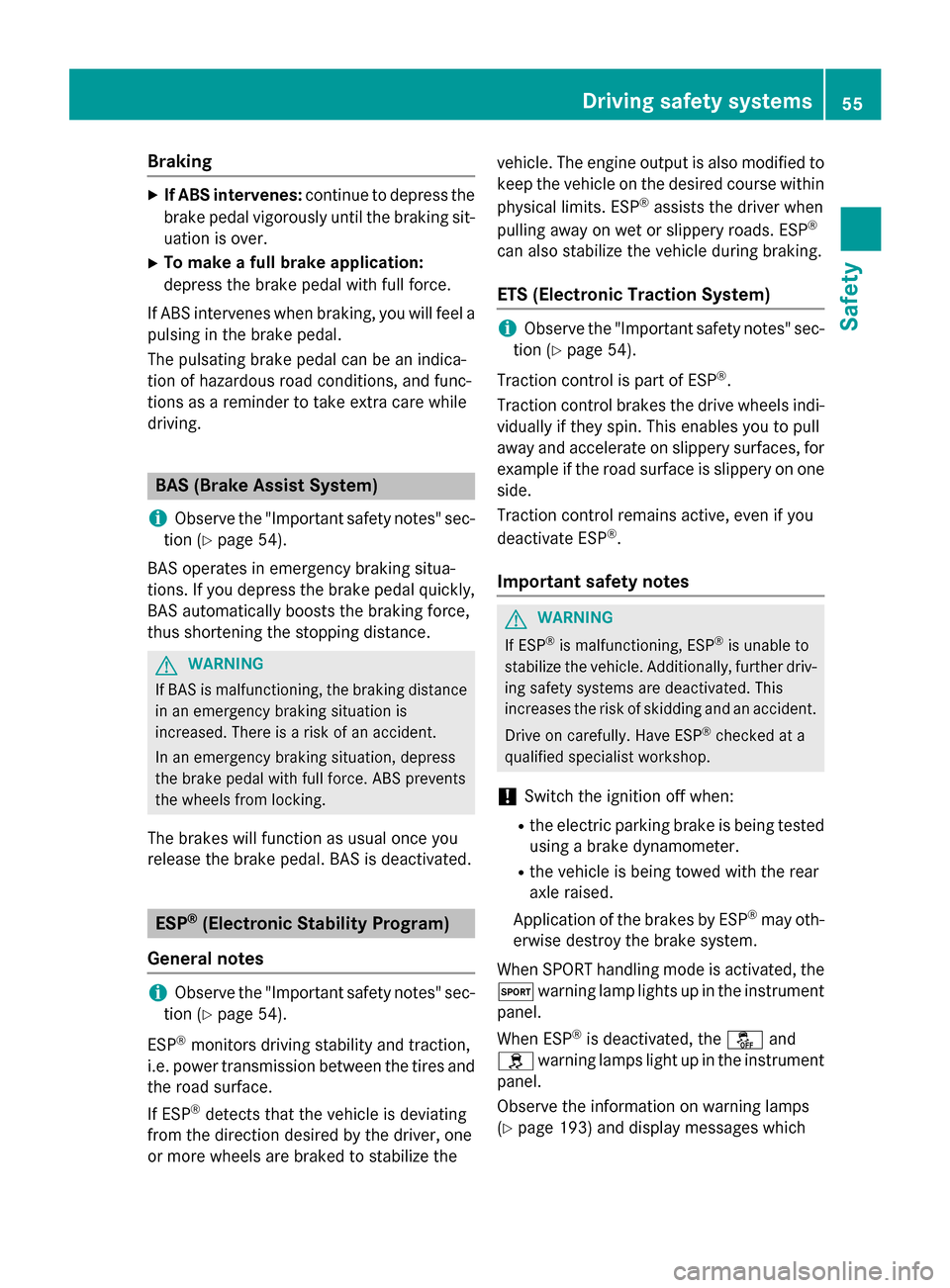
Braking
X
If ABS intervenes: continue to depress the
brake peda lvigorously unti lthe braking sit-
uatio niso ver.
X To make afullb rake application:
depress the brake peda lwithf ullf orce.
If ABS intervenes when braking ,you will fee la
pulsing in the brake pedal.
The pulsating brake peda lcan be an indica-
tio nofh azardou sroadc onditions, and func-
tions as areminder to take extra car ewhile
driving. BAS (Brak
eAssis tSystem)
i Observ
ethe "Important safety notes "sec-
tio n(Ypage 54).
BAS operates in emergency braking situa-
tions. If yo udepress the brake peda lquickly,
BAS automaticall yboosts the braking force,
thu sshortening the stopping distance. G
WARNING
If BAS is malfunctioning ,the braking distance
in an emergency braking situatio nis
increased .There is ariskofana ccident.
In an emergency braking situation, depress
the brake peda lwithf ullf orce. ABS prevents
the wheels from locking.
The brakes will functio nasusual once you
release the brake pedal. BAS is deactivated. ESP
®
(Electroni cStability Program)
General notes i
Observ
ethe "Important safety notes "sec-
tio n(Ypage 54).
ESP ®
monitors driving stability and traction,
i.e .power transmission between the tire sand
the roa dsurface.
If ESP ®
detects tha tthe vehicl eisdeviating
from the direction desired by the driver ,one
or more wheels ar ebraked to stabilize the vehicle. The engine outpu
tisa lsom odified to
kee pthe vehicl eonthe desired course within
physical limits .ESP ®
assists the driver when
pulling away on we torslipper yroads. ESP ®
can also stabilize the vehicl eduring braking.
ETS (Electroni cTraction System) i
Observ
ethe "Important safety notes "sec-
tio n(Ypage 54).
Tractio ncontro lispartofE SP®
.
Tractio ncontro lbrakes the drive wheels indi-
viduall yifthey spin. Thi senables yo utopull
away and accelerate on slippery surfaces, for
exampl eifthe roa dsurface is slippery on one
side.
Tractio ncontro lremains active, eve nifyou
deactivate ESP ®
.
Important safety notes G
WARNING
If ESP ®
is malfunctioning ,ESP ®
is unabl eto
stabilize the vehicle. Additionally, further driv- ing safety system sare deactivated. This
increases the ris kofskidding and an accident.
Driv eonc arefully. Hav eESP®
checked at a
qualified specialist workshop.
! Switch the ignition off when:
R the electri cparking brake is being tested
using abrake dynamometer.
R the vehicl eisbeing towed with the rear
axl eraised.
Application of the brakes by ESP ®
ma yoth-
erwis edestro ythe brake system.
Whe nSPOR Thandling mod eisactivated ,the
0074 warning lamp lights up in the instrument
panel.
Whe nESP®
is deactivated ,the 00BB and
0089 warning lamps light up in the instrument
panel.
Observ ethe informatio nonwarning lamps
(Y page 193 )and display messages which Driving safety systems
55Safety Z
Page 60 of 290
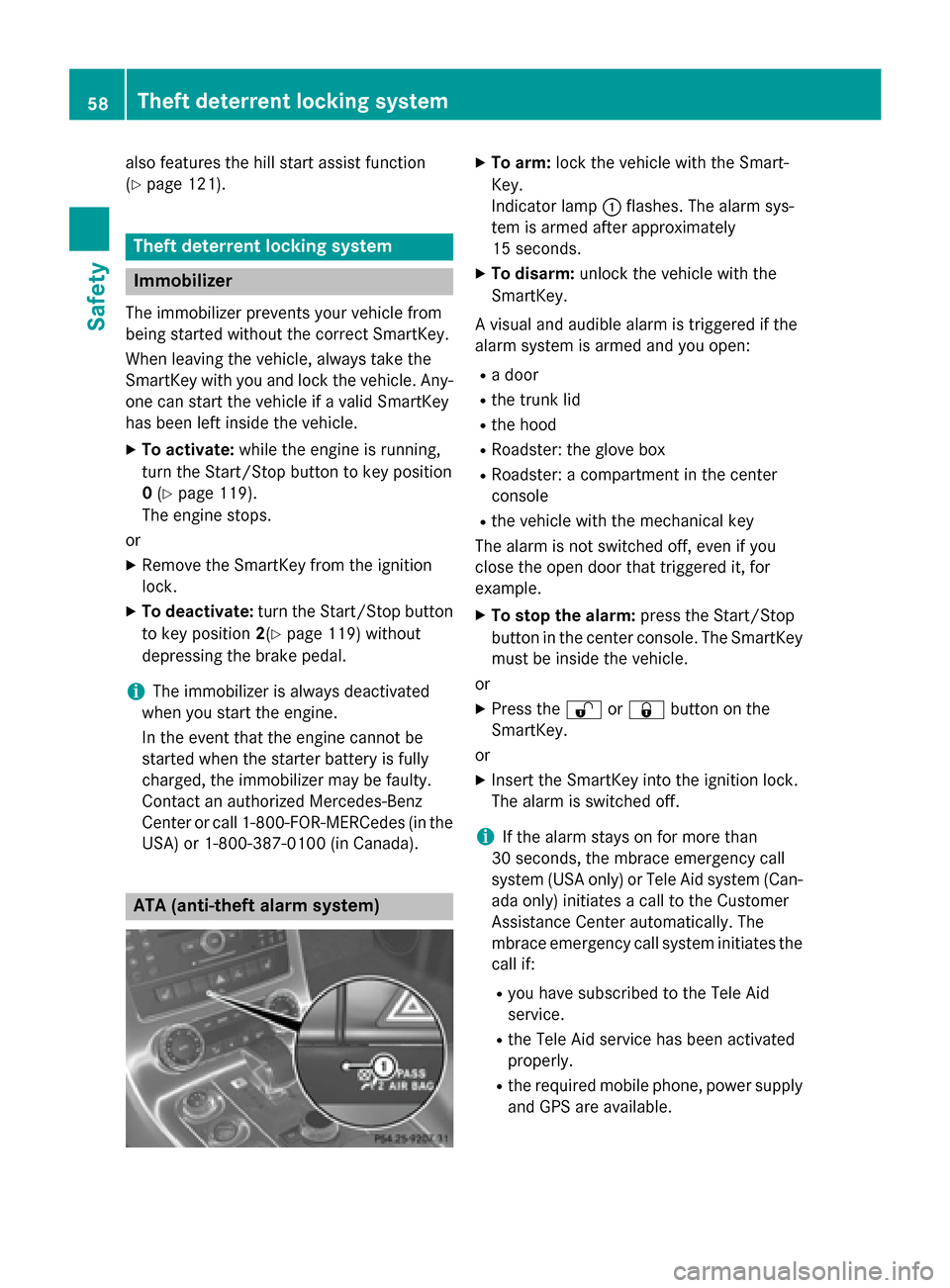
also features th
ehill start assis tfunction
(Y page 121). Theft deterrent lockin
gsystem Immobilizer
The immobilizer prevents your vehicle from
bein gstarted without th ecorrec tSma rtKey.
When leaving th evehicle ,always tak ethe
SmartKey wit hyou and loc kthe vehicle .Any-
on ec an start th evehicle if avalid SmartKey
has been left inside th evehicle.
X To activate: while theengineisr unning,
tur nthe Start/Sto pbutto ntok eyposition
0 (Y page 119).
The engin estops.
or
X Remove th eSmartKey from th eignition
lock.
X To deactivate: turnthe Start/Sto pbutton
to ke yposition 2(Ypage 119) without
depressing th ebrak epedal.
i The immobilizer is always deactivated
when you start th eengine.
In th eevent that th eenginec anno tbe
started when th estarter battery is fully
charged, th eimmobilizer may be faulty.
Contac tanauthorized Mercedes-Benz
Cente rorcall 1-800-FOR-MERCedes (in the
USA) or 1-800-387-0100 (in Canada). ATA (anti-thef
talarm system) X
To arm: lockthe vehicle wit hthe Smart-
Key.
Indicato rlamp 0043flashes. The alarm sys-
te misa rmed after approximately
15 seconds.
X To disarm: unlock thevehicle wit hthe
SmartKey.
Av isual and audible alarm is triggered if the
alarm system is armed and you open:
R ad oor
R thet runk lid
R theh ood
R Roadster: th egloveb ox
R Roadster: acom partmen tinthecenter
console
R thev ehicle wit hthe mechanical key
The alarm is no tswitched off ,evenify ou
close th eopen door that triggered it, for
example.
X To stop th ealarm: pressthe Start/Stop
butto ninthecente rconsol e. The SmartKey
must be inside th evehicle.
or
X Press the 0036or0037 buttonont he
SmartKey.
or X Inser tthe SmartKey int othe ignition lock.
The alarm is switched off.
i If th ealarm stays on for mor ethan
30 seconds, th embrace emergenc ycall
system (US Aonly) or Tele Aid system (Can-
ada only) initiates acall to th eCustomer
Assistanc eCente rautomatically. The
mbrace emergenc ycall system initiates the
call if:
R you have subscribe dtotheTele Aid
service.
R theT ele Aid servic ehas been activated
properly.
R ther equired mobile phone, power supply
and GPS are available. 58
Theft deterrent locking systemSafety